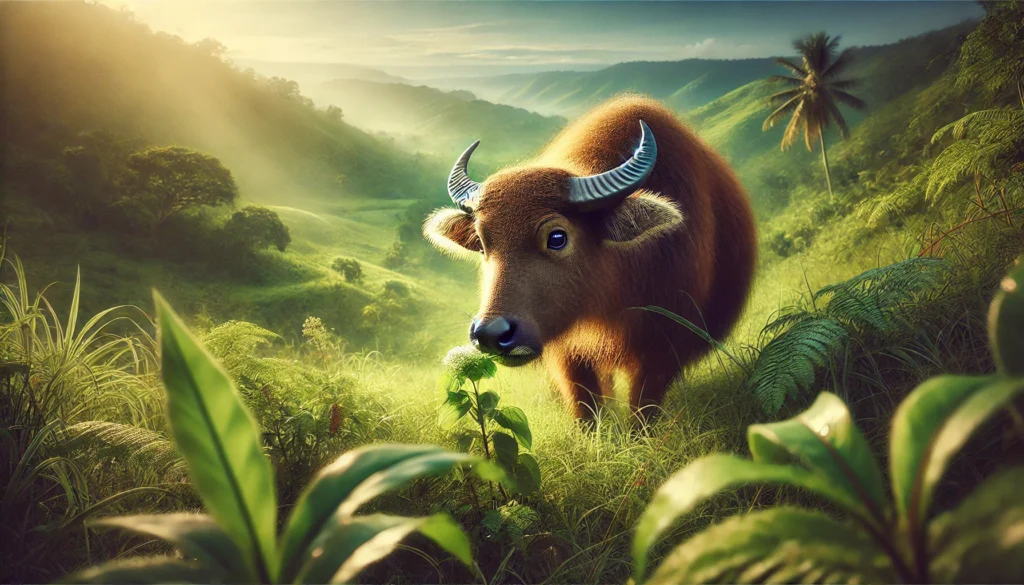Imagine, if you will, a world where buffaloes come in fun-size packages. No, I’m not talking about some futuristic shrink ray experiment gone wrong. I’m referring to the adorable yet endangered Tamaraw, the pint-sized powerhouse of the Philippine island of Mindoro. These diminutive dynamos are like the Danny DeVitos of the bovine world – small in stature but big in personality and importance. Today, we’re diving headfirst into the world of the Tamaraw, exploring why these compact cattle are in trouble, and what’s being done to save them. So buckle up, buttercup, because we’re about to embark on a wild ride through the wilds of Mindoro!
The Tamaraw: Not Your Average Joe Buffalo
What’s in a name?
First things first, let’s get our nomenclature straight. The Tamaraw, scientifically known as Bubalus mindorensis (which sounds like a spell from Harry Potter), is also called the Mindoro dwarf buffalo. Now, don’t let the word “dwarf” fool you – these guys might be small, but they’re mighty. Imagine a buffalo that’s been hit with a shrink ray, and you’ve got yourself a Tamaraw.
Size matters… or does it?
When it comes to the Tamaraw, good things indeed come in small packages. These pint-sized powerhouses stand at a whopping 3 to 4 feet tall at the shoulder. That’s right, folks – we’re talking about a buffalo that’s roughly the size of a large dog. But don’t let their stature fool you; these little guys pack a punch. They weigh in at around 400 to 600 pounds, which is like having a grand piano with horns and hooves. Speaking of horns, the Tamaraw’s are something special – they’re V-shaped and can grow up to 14 inches long. It’s like they’re sporting their own set of natural party hats!
Home sweet home
The Tamaraw is endemic to the island of Mindoro in the Philippines. That’s a fancy way of saying they’re found nowhere else in the world. It’s like they’re the exclusive members of a very elite, very hairy club. Their preferred hangout spots include the island’s montane forests and grasslands. Imagine a lush, green paradise with a dash of mystery and a sprinkle of danger – that’s Tamaraw territory for you.
The Tamaraw Lifestyle: Party of One
Solo artists of the animal kingdom
Unlike their more sociable Asian water buffalo cousins, Tamaraws are the introverts of the bovine world. They prefer to live solitary lives, coming together only when it’s time to make baby Tamaraws. It’s like they’re the millennials of the animal kingdom – independent, a bit mysterious, and only hanging out when absolutely necessary.
Diet and dining habits
When it comes to their diet, Tamaraws are not picky eaters. They’re herbivores, munching on grasses, leaves, and other vegetation. It’s like they’re on a permanent vegan diet, but without the Instagram posts about it. Their feeding habits play a crucial role in maintaining the ecological balance of their habitat. They’re like the unpaid gardeners of Mindoro, pruning and fertilizing as they go.
The circle of life, Tamaraw style
The Tamaraw’s breeding season is typically between November and December. Female Tamaraws give birth to one calf every two years. Talk about family planning! The gestation period lasts about 300 days, which is like being pregnant for almost a year. Ouch! The calves stay with their mothers for about two to four years before heading off on their own solitary adventures. It’s like they have an extended childhood, but without the awkward teenage phase.
The Tamaraw Dilemma: From Abundant to Endangered
A history of decline
Once upon a time, not so long ago, Tamaraws roamed freely across Mindoro. They were as common as selfies are today. But alas, their story took a dark turn. Let’s look at the sobering numbers:
| Year | Estimated Tamaraw Population |
|---|---|
| 1900 | 10,000+ |
| 1949 | 1,000 |
| 1969 | 100 |
| 2000 | 200 |
| 2020 | 480 |
As you can see, the Tamaraw population has been on a roller coaster ride, and not the fun kind. It’s more like the “I think I’m going to be sick” kind. The good news is that recent conservation efforts have shown some positive results, with the population slowly increasing. But we’re not out of the woods yet, folks!
Why the long face? Threats to the Tamaraw
So, what’s been causing all this trouble for our pint-sized pals? Well, it’s the usual suspects:
- Habitat loss: As human populations grow, forests are cleared for agriculture and development. It’s like we’re playing a giant game of Monopoly, and the Tamaraws are losing all their property.
- Hunting: In the past, Tamaraws were hunted for food and sport. It’s like they were the unwilling participants in a real-life version of “The Most Dangerous Game.”
- Disease: Livestock diseases have been known to affect Tamaraws. It’s like they’re dealing with the bovine version of a zombie apocalypse.
- Small population size: With numbers so low, the Tamaraw population is vulnerable to genetic problems and random events. It’s like they’re playing a high-stakes game of genetic roulette.
- Climate change: Alterations in temperature and rainfall patterns can affect the Tamaraw’s habitat and food sources. It’s like Mother Nature is playing a cruel game of musical chairs with their ecosystem.
Conservation Efforts: Operation Save the Mini Moo
The Tamaraw Conservation Program
In 1979, the Philippine government decided it was high time to do something about the dwindling Tamaraw population. They established the Tamaraw Conservation Program (TCP), which is like a superhero team dedicated to saving these pint-sized buffaloes. The TCP has been working tirelessly to protect and increase the Tamaraw population through various initiatives.
Protected areas: VIP lounges for Tamaraws
One of the key strategies in Tamaraw conservation has been the establishment of protected areas. The Mounts Iglit-Baco National Park, covering about 75,445 hectares, is the primary stronghold for the remaining Tamaraw population. It’s like creating an exclusive gated community for these bovine celebrities, complete with 24/7 security and an all-you-can-eat grass buffet.
Breeding programs: Tamaraw matchmaking
Conservation efforts have also included captive breeding programs. However, these have had limited success due to the Tamaraw’s solitary nature and specific habitat requirements. It’s like trying to run a dating service for very picky, very antisocial clients. “Single Tamaraw seeks same for long walks in the montane forest and mutual grass-munching. Must enjoy solitude and have a fondness for V-shaped horns.”
Research and monitoring: Tamaraw paparazzi
Scientists and conservationists are constantly studying and monitoring the Tamaraw population. They use camera traps, field surveys, and other high-tech gadgets to keep tabs on these elusive creatures. It’s like having a team of wildlife paparazzi, but instead of catching celebrities in compromising positions, they’re tracking buffalo poop and hoof prints.
Community involvement: It takes a village to raise a Tamaraw
One of the most crucial aspects of Tamaraw conservation has been involving local communities. After all, you can’t save a species without the support of the people who share its home. Conservation programs have been working to educate local communities about the importance of the Tamaraw and involve them in protection efforts. It’s like creating a neighborhood watch program, but instead of looking out for suspicious characters, they’re keeping an eye out for adorable dwarf buffaloes.
The Cultural Significance of the Tamaraw: More Than Just a Pretty Face
A national treasure
The Tamaraw isn’t just another endangered species; it’s a national symbol of the Philippines. It’s featured on the 1 peso coin and is the mascot of Far Eastern University in Manila. It’s like the Tamaraw is the Betty White of Philippine wildlife – beloved, iconic, and seemingly indestructible (despite the odds).
Indigenous importance
For the indigenous Mangyan people of Mindoro, the Tamaraw holds special cultural significance. It’s featured in their folklore and traditional practices. It’s like the Tamaraw is the star of their own mythological cinematic universe, complete with origin stories and legendary feats.
Ecotourism potential
While Tamaraw spotting isn’t exactly a booming industry yet (these guys are pretty good at social distancing), there’s potential for responsible ecotourism to support conservation efforts. Imagine wildlife safaris where instead of looking for lions and elephants, you’re searching for a buffalo that could fit in the back of a pickup truck. It’s like playing a real-life version of “Where’s Waldo?”, but with more horns and hooves.
The Future of the Tamaraw: Hope on the Horizon?
Conservation goals
The ultimate goal of Tamaraw conservation efforts is to increase the population to a level where it’s no longer considered endangered. It’s like trying to boost your Instagram followers, but with actual lives at stake. The Tamaraw Conservation Program has set ambitious targets:
| Year | Population Goal |
|---|---|
| 2030 | 1,000 |
| 2050 | 5,000 |
Achieving these goals would be like pulling off a magic trick – making Tamaraws appear out of thin air. But with continued conservation efforts and a bit of luck, it might just be possible.
Challenges ahead
Despite the progress made, significant challenges remain. Habitat loss continues to be a major threat, and climate change looms large on the horizon. It’s like the Tamaraw is playing a never-ending game of environmental Whack-A-Mole, with new threats popping up as soon as old ones are addressed.
Reasons for hope
But it’s not all doom and gloom! The slow but steady increase in Tamaraw numbers over the past few decades shows that conservation efforts can make a difference. New technologies, increased awareness, and growing support for conservation provide reasons for optimism. It’s like we’re finally starting to turn the tide in this bovine battle for survival.
Small Buffalo, Big Impact
As we wrap up our journey through the world of the Tamaraw, it’s clear that these pint-sized powerhouses are more than just cute faces in the animal kingdom. They’re ecosystem engineers, cultural icons, and living testaments to the resilience of nature in the face of adversity. The story of the Tamaraw is a reminder that sometimes the most important things come in small packages.
From the lush forests of Mindoro to the coins in our pockets, the Tamaraw has left an outsized imprint on the Philippines and beyond. Its fight for survival is a microcosm of the larger battle to preserve biodiversity in our rapidly changing world. It’s like the Tamaraw is the poster child for endangered species everywhere – small, mighty, and refusing to go down without a fight.
So, the next time you’re feeling overwhelmed by the enormity of environmental challenges, remember the Tamaraw. This pint-sized buffalo teaches us that with determination, teamwork, and a dash of humor, even the smallest among us can make a big difference. Here’s to the Tamaraw – may it continue to roam the forests of Mindoro, reminding us all that good things indeed come in small packages!
Disclaimer: This blog post is based on information available up to 2020. While we strive for accuracy, the dynamic nature of wildlife conservation means that some details may have changed since then. If you spot any inaccuracies or have updated information, please let us know so we can promptly correct them. Remember, when it comes to saving species, every bit of accurate information counts!




